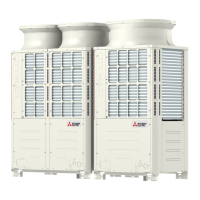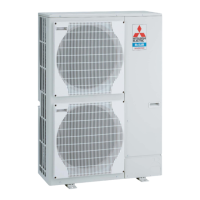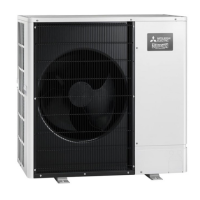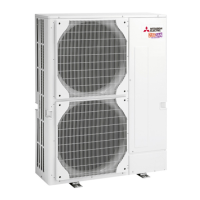[ IX Troubleshooting ]
- 129 -
HWE1018A GB
1. Error Code
High pressure fault 1 (Outdoor unit)
2. Error definition and error detection method
1) If the pressure sensor detects a pressure of 3.78 MPa [548 psi] or higher during operation, the outdoor unit stops, goes into
the 20-second restart delay mode, and automatically restarts after 20 seconds.
2) If the pressure sensor detects a pressure of 3.78 MPa [548 psi] or higher again (second detection) within 30 minutes of the
first stoppage of the outdoor unit, the outdoor unit stops, goes into the 20-second restart delay mode, and automatically re-
starts after 20 seconds.
3) If the pressure of 3.87MPa [561psi] or higher is detected by the pressure sensor (the third detection) within 30 minutes of the
second stop of the outdoor unit, the outdoor unit will make an error stop, and the error code "1302" will be displayed.
4) If the pressure of 3.78MPa [548psi] or higher is detected more than 30 minutes after the stop of the outdoor unit, the detection
is regarded as the first detection, and the operation described in step 1 above will start.
5) For 30 minutes after the stop of the outdoor unit, preliminary errors will be displayed on the LED display.
6) The outdoor unit makes an error stop immediately when not only the pressure sensor but also the pressure switch detects
4.15
+0,-0.15
MPa [601
+0,-22
psi]
7) Open phase due to unstable power supply voltage may cause the pressure switch to malfunction or cause the units to come
to an abnormal stop.
3. Cause, check method and remedy
1302
Cause Check method and remedy
(1) Outdoor unit LEV2 actuation failure -> Cooling
Indoor unit LEV actuation failure -> Heating
Perform a cooling or heating operation to check the oper-
ation.
Cooling: Outdoor unit LEV2
Heating: Indoor unit LEV
Refer to the section on troubleshooting the LEV.
(page 185)
(2) Closed refrigerant service valve Confirm that the refrigerant service valve is fully open.
(3) Short cycle on the indoor unit side Check the indoor units for problems and correct them, if
any.
(4) Clogged filter on the indoor unit
(5) Reduced air flow due to dirty fan on the indoor
unit fan
(6) Dirty heat exchanger of the indoor unit
(7) Indoor fan (including fan parts) failure or motor
failure
Rise in high pressure caused by lowered con-
densing capacity in heating operation for (2) - (7).
(8) Short cycle on the outdoor unit Check the outdoor units for problems and correct them, if
any.
(9) Dirty heat exchanger of the outdoor unit
(10) Outdoor fan (including fan parts) failure, motor
failure, or fan controller malfunction
Rise in discharge temp. by low pressure drawing
for (8) - (10).
Check the fan on the outdoor unit.
Refer to the section on troubleshooting the outdoor unit
fan.(page 184)
(11) Solenoid valve (SV1a) malfunction (The by-pass
valve (SV1a) can not control rise in high pres-
sure).
Refer to the section on troubleshooting the solenoid
valve.(page 183)
(12) Thermistor failure (TH3, TH7) Check the thermistor resistor.(page 143)
(13) Pressure sensor failure Refer to the page on the troubleshooting of the high pres-
sure sensor. (page 181)
(14) Failure of the thermistor input circuit and pres-
sure sensor input circuit on the controller board
Check the temperature and the pressure of the sensor
with LED monitor.
(15) Thermistor mounting problem (TH3, TH7) Check the temperature and the pressure of the sensor
with LED monitor.
(16) Disconnected male connector on the pressure
switch (63H1) or disconnected wire
(17) Voltage drop caused by unstable power supply
voltage
Check the input voltage at the power supply terminal block
(TB1).
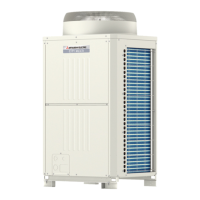
